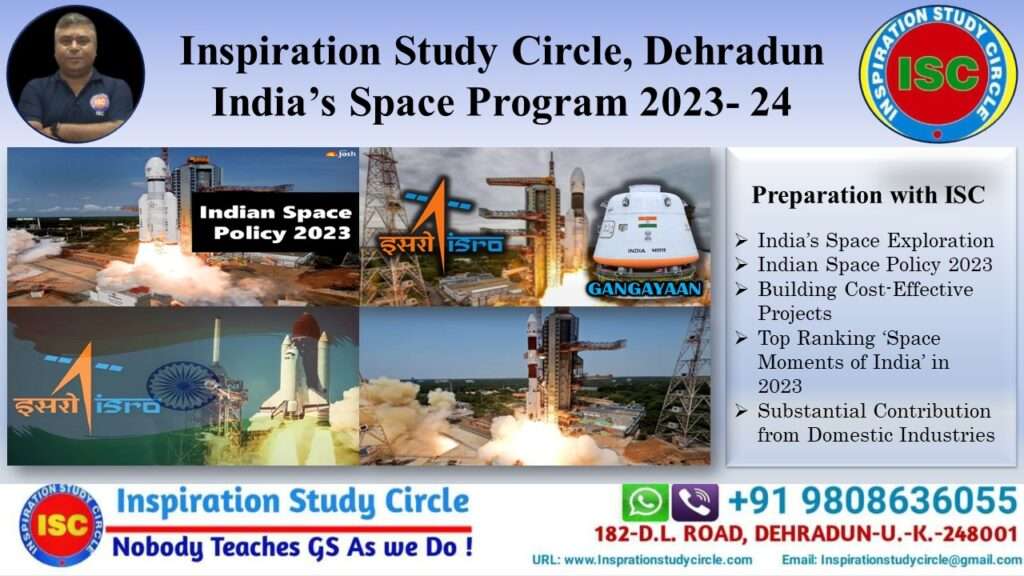
Last Minute Preparation Tips for UK PCS Prelims 2025
Last Minute Preparation Tips for UK PCS Prelims 2025 Table of Contents Inspiration Study Circle Last Minute Preparation Tips for UK PCS Prelims 2025 Last
The Indian space program, led by the Indian Space Research Organisation (ISRO), has made significant advancements in space exploration, satellite technology, and scientific research.
Indian Space Research Organization (ISRO) is the space agency of India. The organization is involved in science, engineering, and technology to reap the benefits of outer space for India and mankind. ISRO is a major component of the Department of Space (DOS) of the Government of India. The department manages the Indian space program primarily through various centers or units within ISRO.
ISRO was formerly the Indian National Committee for Space Research (INCOSPAR), which was Conceived by Dr. Vikram Sarabhai and established by the Government of India in 1962. ISRO was formed on August 15, 1969, and replaced INCOSPAR with an expanded role to exploit space technology. DOS was established and ISRO was brought under DOS in 1972.
The main objective of ISRO/DOS is to develop and apply space technology for various national needs. To fulfill this objective, ISRO has established major space systems for communication, television broadcasting, and meteorological services; monitoring and management of resources; and Space-based navigation services. ISRO has developed Satellite Launch Vehicles, PSLV, and GSLVs to put the satellites into the required orbits.

India’s space agency, the India Space Research Organization (ISRO), marked a trail for many to follow in 2023. Not only did it become the first nation to land on the Moon’s South Pole with Chandrayaan-3, but it also launched its first dedicated sun-observing spacecraft, the Aditya L1. These groundbreaking feats further cemented India’s position as the 5th country with complete space research and development capabilities.
India is fifth among nations with end-to-end capabilities in space research and development, including the ability to launch from our soil and run programs in Earth observation, satellite communications, meteorology, space science and navigation, and ground infrastructure.
27 satellites and 22 Launch Vehicle missions have been accomplished during the period (July 2018 – July 2023), besides the successful Pad Abort Test (PAT) to qualify the Crew Escape System (CES) in July 2018 and the Reusable Launch Vehicle autonomous landing mission in April 2023.
In 2023, the Government of India launched a National Space Policy to leverage India’s unique expertise in this field. The policy has been formulated as a comprehensive, dynamic, and integrated framework to implement the Government of India’s vision of space reform. The government made reforms in this sector in 2020 opened the doors to the private sector and provided them with a level playing field.
The ‘Vision’ of India’s Space Policy is to “enable, encourage and develop a rich commercial presence in space” which implies the recognition that the private sector is an important stakeholder in the entire value chain of the space economy.
The policy creates four separate, but related units, which will facilitate greater private sector participation in activities that have generally been the traditional domain of ISRO.
InSPACe (Indian National Space Promotion and Authorization Centre): It will be a window clearance and authorization agency for space launches, establish launch pads, buy and sell satellites, and disseminate high-resolution data among other things. It will also share technologies, products, processes, and best practices with NGOs (non-governmental organizations and this will include private companies) and government companies. IN-SPACE will create a “stable and predictable regulatory framework” that will ensure a level playing field for NGEs. It will act as a promoter by setting up industry clusters and issuing guidelines on liability issues as a regulator.
New Space India Limited (NSIL): It will be responsible for the commercialization of space technologies and platforms created through public expenditure as well as manufacturing, leasing, or procurement of space components, technologies, platforms, and other assets from the private or public sector.
Department of Space: It will provide overall policy guidelines and be the nodal department for the implementation of space technologies and coordinate international cooperation and coordination in the field of global space governance and programs, inter alia, in consultation with the Ministry of External Affairs.
Explicating ISRO’s role: It states that ISRO will transition from the existing practice of being present in the production of operational space systems. ISRO will focus on R&D in advanced technology, proving new systems and realizing space objects to meet national priorities. It will share technologies, products, processes, and best practices with other government and non-government companies. This will enable ISRO to use all its strength on cutting-edge research and development and long-term projects.
The Indian Space Research Organisation (ISRO) has been at the forefront of space exploration and satellite technology since its inception in 1969. It has conducted a total of 124 spacecraft missions, including 17 satellites developed by private players or students and 432 foreign satellites launched.
Additionally, ISRO has also completed 96 launch missions, six re-entry missions, and projects like POEMS. The organization is also preparing for the Gaganyaan mission, India’s first manned spaceflight, highlighting its advancements in space technology and exploration. Let us have a look at the timeline of the several achievements of ISRO for India’s Ambitious Space Program:
1975 | Aryabhata | Satellite | India’s first satellite. It was launched for scientific and technological research. |
1980 | Rohini Satellite Series (RS-1) | Satellite | India’s first satellite was launched by its launch vehicle, the SLV-3. |
1983 | INSAT-1B | Communication Satellite | Part of the Indian National Satellite System for telecommunications, broadcasting, and meteorology. |
1987 | SROSS Series (SROSS-1) | Satellite | Series of satellites for scientific research and observation. |
1993 | IRS-1E | Earth Observation | Part of the Indian Remote Sensing program for resource monitoring and management. |
1999 | INSAT-2E | Communication Satellite | Advanced communication satellite for broadcasting and telecommunications. |
2001 | GSAT-1 | Communication Satellite | Experimental satellite for testing new technologies in communication. |
2005 | Cartosat-1 | Earth Observation | High-resolution mapping satellite for cartographic applications. |
2008 | Lunar Exploration | India’s first lunar probe, which discovered water molecules on the Moon. | |
2013 | Mars Orbiter Mission (Mangalyaan) | Mars Exploration | India’s first interplanetary mission, which made India the first Asian nation to reach Martian orbit. |
2014 | IRNSS-1C | Navigation | Part of the Indian Regional Navigation Satellite System for providing accurate position information. |
2015 | Astrosat | Space Observatory | India’s first dedicated multi-wavelength space observatory for astronomical observations. |
2016 | GSAT-18 | Communication Satellite | Advanced communication satellite to support telecommunication, broadcasting, and broadband services. |
2017 | Cartosat-2 Series Satellite | Earth Observation | High-resolution earth observation satellite for cartographic and military applications. |
2018 | GSAT-29 | Communication Satellite | High-throughput communication satellite to provide broadband connectivity to rural and remote areas. |
2019 | Chandrayaan-2 | Lunar Exploration | India’s second lunar mission, aimed at exploring the Moon’s south pole region, was partially successful. |
2020 | GSAT-30 | Communication Satellite | Replacement satellite for INSAT-4A, providing enhanced communication services. |
2021 | PSLV-C51/Amazonia-1 | Satellite Launch | Polar Satellite Launch Vehicle mission carrying Brazil’s Amazonia-1 satellite and 18 co-passenger payloads. |
2022 | GSAT-24 | Communication Satellite | A communication satellite was launched for NewSpace India Limited (NSIL) to provide DTH television services. |
2023 | LVM3-M3/OneWeb India-1 | Satellite Launch | Launch of 36 OneWeb broadband communication satellites aboard the LVM3 rocket. |
2023 | Aditya-L1 | Solar Exploration | India’s first solar mission was to study the sun’s outer atmosphere, known as the solar corona, and investigate the sun’s chromosphere using a near-ultraviolet instrument. |
2023 | Chandrayaan-3 | Lunar Exploration | To demonstrate the ability to safely land on the moon and deploy a rover for exploration. |
2024 | X-ray Polarimeter Satellite (XPoSat) | Satellite Launch | Launched to investigate the polarisation of cosmic X-rays and examine the 50 brightest known celestial objects in the universe. |
India’s space exploration future looks promising, as the country has been making significant progress in the field in recent years. The Indian Space Research Organisation (ISRO) has been actively involved in various space missions and has set ambitious goals for the future.
Human Spaceflight Program: ISRO is working towards sending Indian astronauts into space. The Gaganyaan mission is India’s first manned space mission, which aims to carry a crew of two or three astronauts into a low Earth orbit. The program is scheduled for 2022 and will make India the fourth country to send humans to space.
Mars Mission: Building on the success of the Mars Orbiter Mission (Mangalyaan) in 2014, which made India the first country to reach Mars on its maiden attempt, ISRO has plans for future Mars missions. These missions will focus on studying the Martian atmosphere, climate, and geology in greater detail.
Interplanetary Missions: ISRO has expressed interest in exploring other planets and celestial bodies. There have been discussions about potential missions to Venus, Jupiter, and even asteroids. These missions would contribute to our understanding of the solar system and expand India’s footprint in deep space exploration.
Satellite Launches and Communication: India has established itself as a reliable and cost-effective option for satellite launches. ISRO’s Polar Satellite Launch Vehicle (PSLV) and Geosynchronous Satellite Launch Vehicle (GSLV) are renowned for their capabilities. India will continue to launch satellites for various purposes, including communication, weather monitoring, earth observation, and scientific research.
International Collaboration: India has been actively collaborating with other countries and space agencies on various space missions. Collaborative projects provide an opportunity to share resources, knowledge, and technology, enabling India to undertake more ambitious missions and advance its space exploration capabilities.
Space Industry Development: India is also focusing on developing its space industry. Initiatives such as the Space Activities Bill, which aims to encourage private sector participation in space activities, and the establishment of the Indian National Space Promotion and Authorization Center (IN-SPACe), demonstrate India’s commitment to fostering a thriving space industry.
Overall, India’s space exploration future is characterized by its determination to expand its capabilities, explore new frontiers, and contribute to scientific knowledge. With ambitious missions, technological advancements, and a growing space industry, India is poised to make significant contributions to the global space community in the coming years.
The Indian Space Research Organization (ISRO) has an ambitious series of upcoming space missions, demonstrating its commitment to advancing space exploration and technology. Here is the table of upcoming space missions by ISRO.
2024 | Gaganyaan 1 | Human Spaceflight | The first test flight of the Gaganyaan spacecraft, designed to carry three astronauts and equipped with rendezvous and docking capabilities. |
2024 | NISAR | Earth Observation | A joint project with NASA to launch a dual-frequency synthetic aperture radar satellite for remote sensing is notable for being the first dual-band radar imaging satellite. |
Mid-2025 | Gaganyaan 2 | Human Spaceflight | The second test flight before the inaugural crewed mission. |
2025 | Venus Orbiter Mission (Shukrayaan) | Planetary Exploration | An orbiter mission to study the atmosphere of Venus. |
2026 | Mars Orbiter Mission 2 (Mangalyaan 2) | Planetary Exploration | India’s second interplanetary mission to Mars is primarily an orbiter mission. |
2026 | Lunar Polar Exploration Mission | Lunar Exploration | A concept mission in collaboration with JAXA to explore the Moon’s south pole region. |
2026 | Gaganyaan 3 | Human Spaceflight | The first crewed Gaganyaan mission aimed to make India the fourth country to independently send humans to space. |
2028 | Chandrayaan-4 | Lunar Exploration | A lunar sample-return mission, the fourth in the Chandrayaan series, consists of multiple modules for different mission phases. |
2028–2035 | Bharatiya Antariksha Station | Human Spaceflight | A planned space station that would weigh 20 tonnes and maintain an orbit approximately 400 kilometers above Earth, where astronauts could stay for 15–20 days. |
TBD | AstroSat-2 | Astronomy and Astrophysics | A space telescope is proposed as the successor to Astrosat-1, with an ‘Announcement of Opportunity’ issued for ideas and the development of instruments for astronomy and astrophysics. |
Disclaimer: the above-mentioned article is based on information from the Press Information Bureau of India, and the Indian Express.

Last Minute Preparation Tips for UK PCS Prelims 2025 Table of Contents Inspiration Study Circle Last Minute Preparation Tips for UK PCS Prelims 2025 Last

India at the 51st G7 Summit, Canada Table of Contents Inspiration Study Circle India at the 51st G7 Summit, Canada India at the 51st G7

How to Crack the UKPSC 2025 Mains Exam? Table of Contents Inspiration Study Circle, Dehradun How to Crack the UKPCS Mains Exam 2025? How to

UKPSC 2025 Calendar Updated Table of Contents Inspiration Study Circle UKPSC- 2025 Calendar Updated UKPSC 2025 Calendar Updated The Uttarakhand Public Service Commission released an

India becomes the World’s Fourth Largest Economy Table of Contents Inspiration Study Circle India Becomes the World’s Fourth-Largest Economy On 24th May, 2025, NITI Aayog

UPSC Prelims 2025 Analysis Table of Contents ISC Explained and Analysed Question Paper: UPSC CSE Prelims 2025 UPSC Prelims 2025 Analysis The Union Public Service